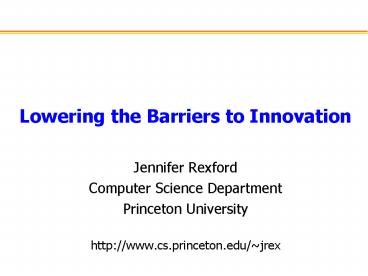Lowering the Barriers to Innovation PowerPoint PPT Presentation
Title: Lowering the Barriers to Innovation
1
Lowering the Barriers to Innovation
- Jennifer Rexford
- Computer Science Department
- Princeton University
- http//www.cs.princeton.edu/jrex
2
Flash Back to 1984
3
Fast Forward to Today
- How computers work
- Electrical engineering degree at Princeton
- Making multiple computers work together
- Parallel computing research at U. Michigan
- Interconnecting computers via the Internet
- Research at ATT Labs
- Designing the future Internet
- Research and teaching with undergraduate and
graduate students at Princeton
4
How the Internet Enables Innovation
5
Innovative Applications
Tim Berners-Lee CERN Researcher World Wide Web
iPhone apps
6
Innovative Communication Media
Cable
Satellite
Cellular
Ethernet
DSL
Bluetooth
WiFi
Fiber optics
7
Telephone Network
Smart Network
Dumb Terminals
8
Plain Old Telephone Service (POTS)
- Dumb phones
- Dial a number
- Speak and listen
- Smart switches
- Set up and tear down a circuit
- Forward audio along the path
- Limited services
- Audio
- Later, fax, caller-id,
- A monopoly for a long time
9
Internet
Dumb Network
Smart Terminals
10
Power at the Edge
End-to-End Principle Whenever possible,
communications operations should occur at the
end-points of a system.
Programmability With programmable end hosts, new
network services can be added at any time, by
anyone.
And then computers became powerful and
ubiquitous.
11
What Does the Dumb Network Do?
- Best-Effort Packet Delivery
12
Internet Protocol (IP) Packet Switching
- Much like the postal system
- Divide information into letters
- Stick them in envelopes
- Deliver them independently
- And sometimes they get there
- Whats in an IP packet?
- The data you want to send
- A header with the from and to addresses
13
Why Packets?
- Data traffic is bursty
- Logging in to remote machines
- Exchanging e-mail messages
- Dont waste bandwidth
- No traffic exchanged during idle periods
- Better to allow sharing of resources
- Different transfers share access to same links
14
Why Best Effort?
- Best-effort delivery
- Packets may be lost, corrupted, delayed, or
delivered out-of order - Keeps the network simple
- No retransmission, error correction, or
guarantees of packet delivery,
source
destination
IP network
15
Supporting Diverse Link Technologies
- Best-effort packet delivery over most anything
- Serial link, fiber optic link, coaxial cable,
wireless - Even birds
- IP Datagrams over Avian Carriers
IP over Avian Carriers was actually implemented,
sending 9 packets over a distance of
approximately 3 miles, each carried by an
individual pigeon, and they received 4 responses,
with a packet loss ratio of 55, and a response
time ranging from 3000 seconds to over 6000
seconds.
16
Power to the Users Computer
Run neat applications!
Operating System
- Overcome network limitations
- Retransmit lost or corrupted packets
- Put the received data back in order
- Slow down under congestion
packets
17
The Result Tremendous Innovation
Internet Protocol
18
So, Whats the Problem?
- (And where do I come in?)
19
Misplaced Trust in the End Host
- Security vulnerabilities
- No strict notions of identity
- Powerful computers
- Many attacks
- Denial of service
- Spam e-mail
- Phishing
- Identity theft
- How do we protectthe Internet?
20
Nobody is In Charge
Around 50,000 independent networks
4
3
5
2
6
7
1
Web server
Client
How to manage a global federated network?
21
Hard to Change the Inside of the Internet
- Internet infrastructure
- Scalability
- Stability
- Reliability
- Performance
- Energy-efficiency
- Security
Internet Protocol
- Can we make the inside programmable?
- To unleash a wave of innovation
22
My Research Challenge
- A future Internet worthy of our trust
- More secure, scalable, stable, reliable,
efficient, - More flexible and evolvable over time
- Despite all the challenges
- Greedy and malicious users
- Networks driven by economics and politics
- Without losing all the good stuff
- Innovative applications
- Innovative communication media
- I think this will keep me busy for awhile! ?
23
What I Love About My Job
- Learn new stuff all the time
- Pick the research problems I work on
- Pick the people I want to work with
- Have real impact on the world today
- And (hopefully) bigger impact in the future
- While wearing jeans to work every day!
24
Thanks!
- (Any Questions?)

